You might think that a wasp two inches long with a stinger that resembles a cactus spine and the word “killer” as part of its name is the baddest bug in the neighborhood. Undeniably, the cicada killer wasp is an intimidating package for a predator as it goes about its business of paralyzing cicadas and hauling them back, belly up, to its burrow for its larval offspring to nosh alive.
The cicada killer—actually, the female as the stingless male dies after mating—is big and belligerently buzzy, with vivid colors on its wings, warning that its stinger is not for show. Even so, in the natural world, even fearsome creatures have enemies.
Velvet Underground
The cicada killer is formidable, but it does indeed have enemies, although not many as an adult. A few species of assassin bugs rarely may ambush adult cicada killers among flowers as they feed on nectar. Large spiders sometimes snag one in their web. A bird or two may grab one of these wasps as well, but not often.
It is most vulnerable as a larva, when it feeds upon the catatonic cicada its parent has stashed in a nest chamber. In an ironic case of turnabout is fair play, the larval cicada killer may become host to the larvae of other insect that manages to parasitize it.
The cicada killer larva hatches from an egg in a chamber, or cell, provisioned with one to three cicadas, the annual variety not the “periodic” cicadas that appear every 13 years and 17 years. A single burrow, dug by the female and several feet long, may contain a half dozen or so nest cells, each carefully sealed by its builder.
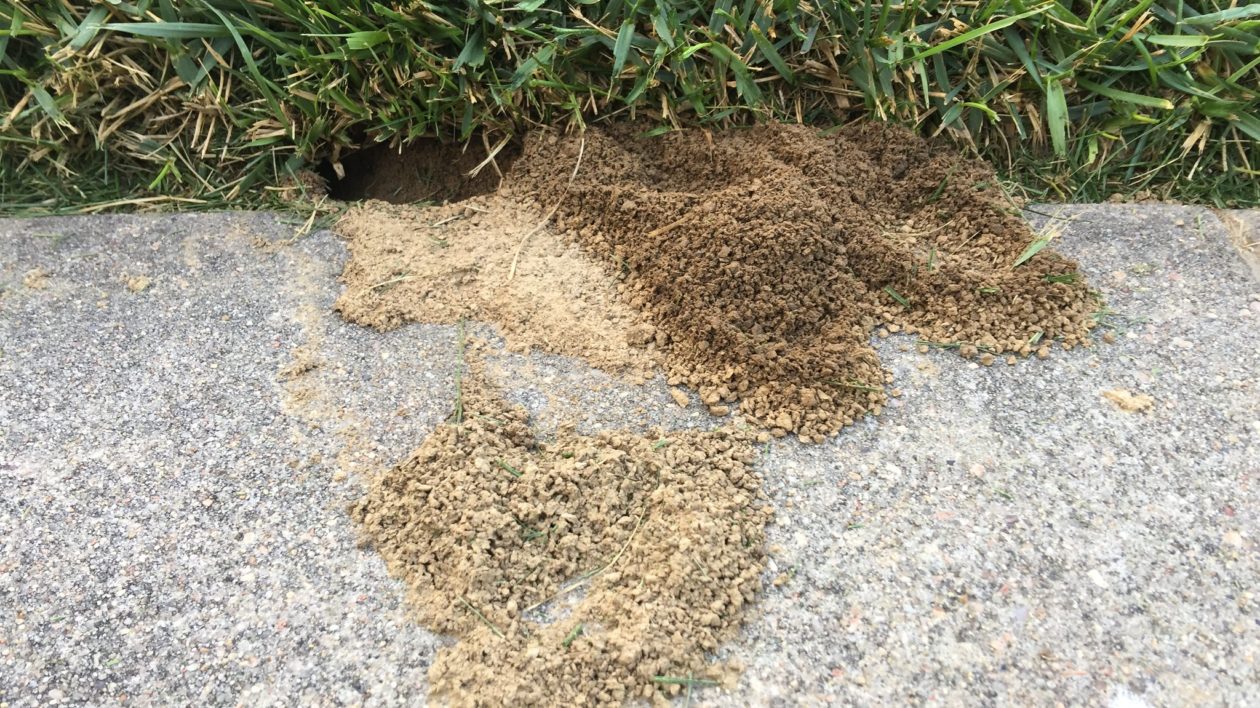
Sealed or not, the nests apparently are breached by the wingless parasitoid wasp incorrectly known as the velvet ant, a colorful creature emblazoned with brilliant orange or red and black. It sneaks into the cicada killer burrow, enters the nest chamber and “gifts” the cicada killer larvae with its own egg.
The pupal stage of the cicada as well is vulnerable to the velvet ant, according to the University of Florida, Journal of Entomological Science. That said, direct observations of the velvet ant’s depredations are difficult to find. Much of what is written about how the velvet ant bedevils the cicada killer is based on observations of it as a parasitoid of other ground-nesting wasps and bees.
Everything You Need to Know about Cicadas
Have questions about the world of Cicadas? We have answers
Cicada killer expert Dr. Joseph Coelho of Quincy University in Illinois, “I have seen many velvet ants in the area of cicada killer colonies, but I have never seen their interactions at all. I am unaware of any literature that describes it specifically.”
Another expert on the species, Charles (Chuck) W. Holliday, professor emeritus at Pennsylvania’s Lafayette College, who partners with Coelho on cicada killer research, adds, “I’ve only seen female velvet ants digging in known cicada killer nesting areas, so I don’t know what they do when they go down open burrows or dig down into closed ones.”
Assaults against the cicada killer larva come from the air as well as below ground. Cicada killers flying home are often closely tailed by a pesky squadron of parasitoid flies, belonging to the subfamily Miltogrammatinae, which produce live larvae instead of eggs. The Miltogrammines are known as satellite flies because the way they hover around the wasps that are their intended targets.
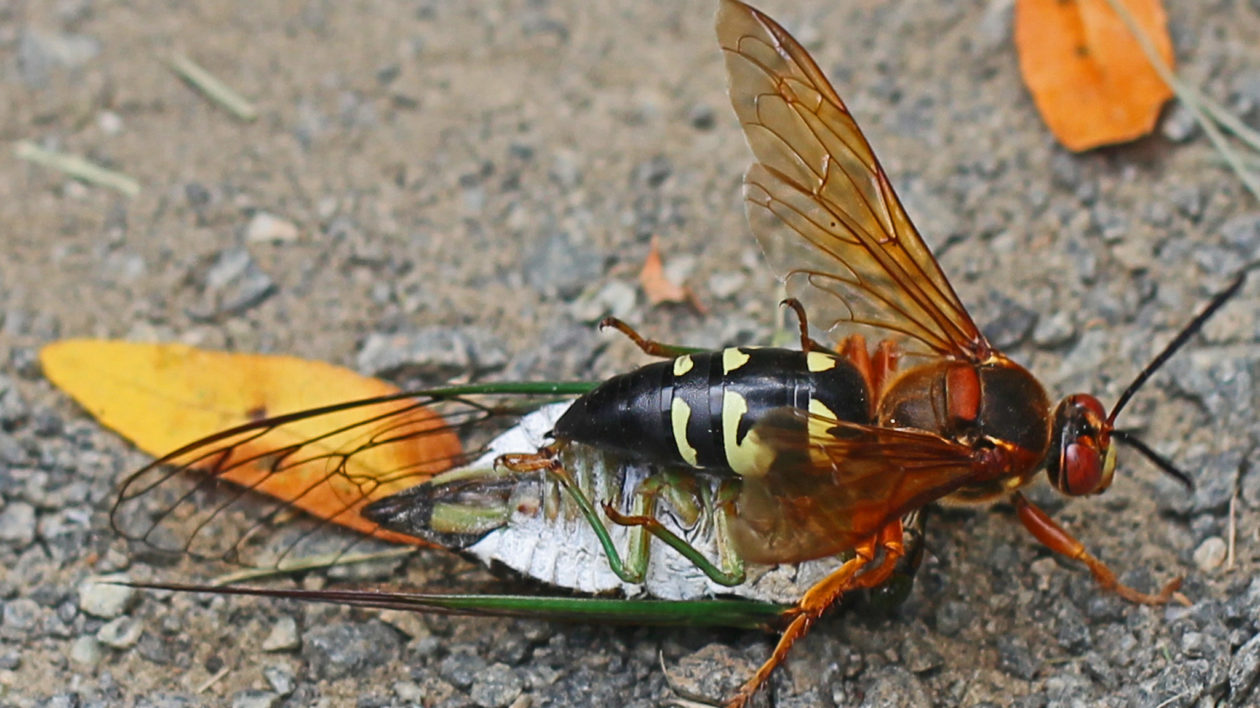
Prey Theft and Other Tricks
Or rather, it is the prey of the wasp that is the target. Satellite flies engage in a form of thievery known as “kleptoparasitism,” taking another creature’s prey. They drop their larvae – maggots – on the cicada that the female cicada killer is hauling home, sometimes in spectacular fashion. Holliday says he has seem the flies drop larvae like dive bomber, with unerring accuracy from above, to land on a paralyzed cicada being dragged by a wasp “ just as it disappears down a burrow.”
If a fly acts sufficiently early, however, it lands on the cicada while still in the wasp’s grasp and leaves its maggot behind before buzzing off.
Contending with other kleptoparasitic species is bad enough but the female cicada killer must also worry about back-stabbing sisters. Field studies by Coehlo and Holliday, at the legendary desert ghost town of Ruby, Arizona and on the leafy campus of Lafayette revealed that some females try to covertly lay their egg on a cicada in another’s burrow.
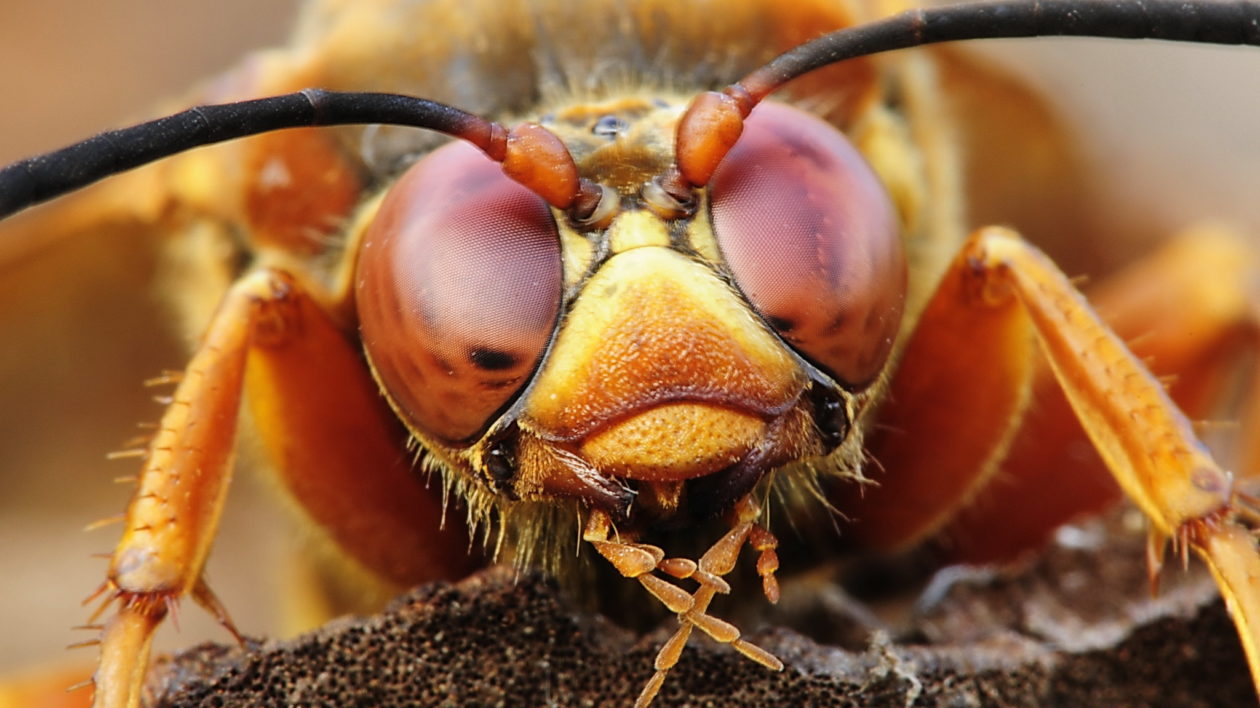
The scientists noticed female wasps entering the burrows of other females, while the owner was away hunting. Sometimes the owner would return and evict the trespasser. They spied on the trespassing females by luring them into a “trap nest” device that mimicked burrows and the nest cells. A PVC pipe simulated the burrow and a plastic cup the cell. “If we had not utilized trap nests, we would not have known that it was occurring at all,” they say.
Appropriating another’s cicada is a strategy by which females that may have difficulty obtaining their own prey because of small size, heavy competition or scarce cicadas may be able to reproduce, the scientists reported in the Journal of Insect Science. “We suggest that provisioned nest cell kleptoparasitism may have evolved in cicada killers as an alternative strategy to standard provisioning, given the dual uncertainties of adult body size and prey availability,”
It makes sense from an evolutionary standpoint, because the female committing the home invasion expends less time and energy resources that catching a cicada on its own.
Hunting cicadas and ferrying them back is grueling work. Like cicadas, cicada killer spends its youth underground, wintering as a larva in a cocoon, pupating and emerging early enough in the summer so that it can mate and be ready to lay eggs by the time the cicadas arise from the soil.
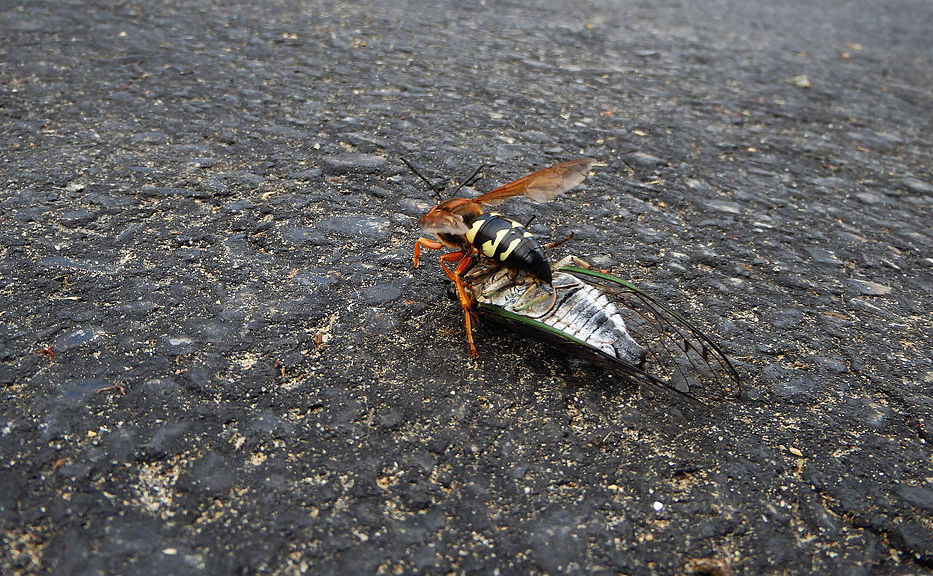
After a female cicada-killer wasp mates in early summer, she digs a burrow, preferably in light, well-drained soil. Spots with optimum soil may contain large clusters of burrows dug by multiple wasps. Next, she must search out a cicada in the trees, sting it and lug it home.
The wasps occasionally pluck them out of the air but usually hunt them by sight in the vegetation. Cicada killers are big but cicadas even bigger, often larger than the load-bearer, sometimes so heavy the cicada-killer must haul its prey to a launch point well up in vegetation to get airborne.
A wasp loaded down by a cicada payload is easy to spot and about as maneuverable against kingbirds as a cargo plane attacked by fighters, a slow, big target, in effect. And that is when it must run the gauntlet of another batch of prey pirates, Cassin’s kingbirds and thick-billed kingbirds. At least, that is what the happened at the Ruby site during the study by Coehlo, Holliday and colleague John Hastings of Northern Kentucky University,
Kingbirds perched atop mesquite bushes and dead agave waited for loaded-down wasps, sallying forth and snatching away their cicadas as they homed in on their burrows. About half the wasps observed lost their cargo, which could create a significant drain on their population. Piracy works to the advantage of the kingbirds, on the other hand, because requires much less time and energy than looking for the cryptically colored cicadas hidden in foliage.
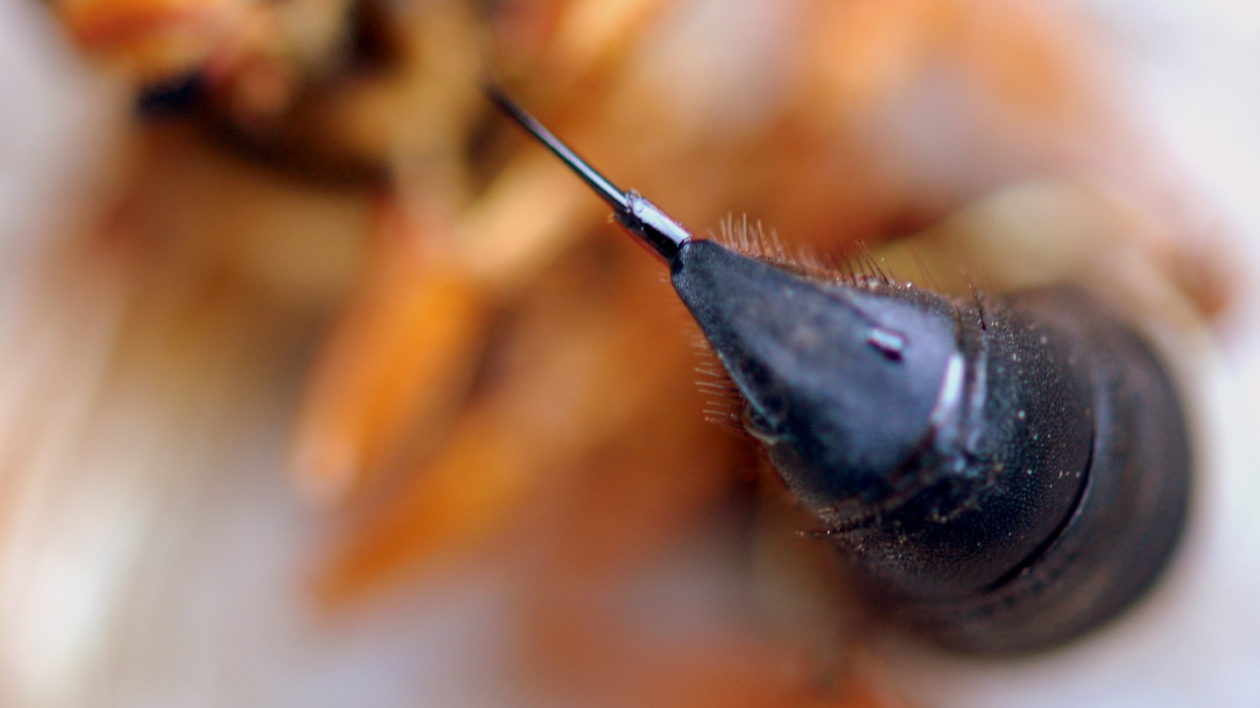
The Most Deadly Enemy
Perhaps the most deadly enemy of the cicada killer does not want to eat it or its prey. It is the human, mostly the variety who wants lawn that is the envy of the neighbors. Cicada killer tunnels can riddle a lawn, or a garden, for that matter.
Search the web for “cicada killer” and page after page of web sites, many from pest control companies, suggest ways to eliminate the wasps. On their part, they turn the other cheek towards humans.
Although their sting packs a wallop, cicada killers generally are not aggressive towards people and even have been handled without harm.
It is possible that human antipathy towards the cicada killer may increase with the discovery that the equally robust northern giant hornet has been discovered in the United States. Dubbed by the media the “Murder Hornet” because it is aggressive and has a dangerous sting, news stories about the hornet have created no small amount of panic.
The northern giant hornet is scary, true, but its close cousin, the European hornet, has been here since the 1840s. It, too, has been confused with cicada killers but is not aggressive and doesn’t attack bee hives so it causes far less alarm.
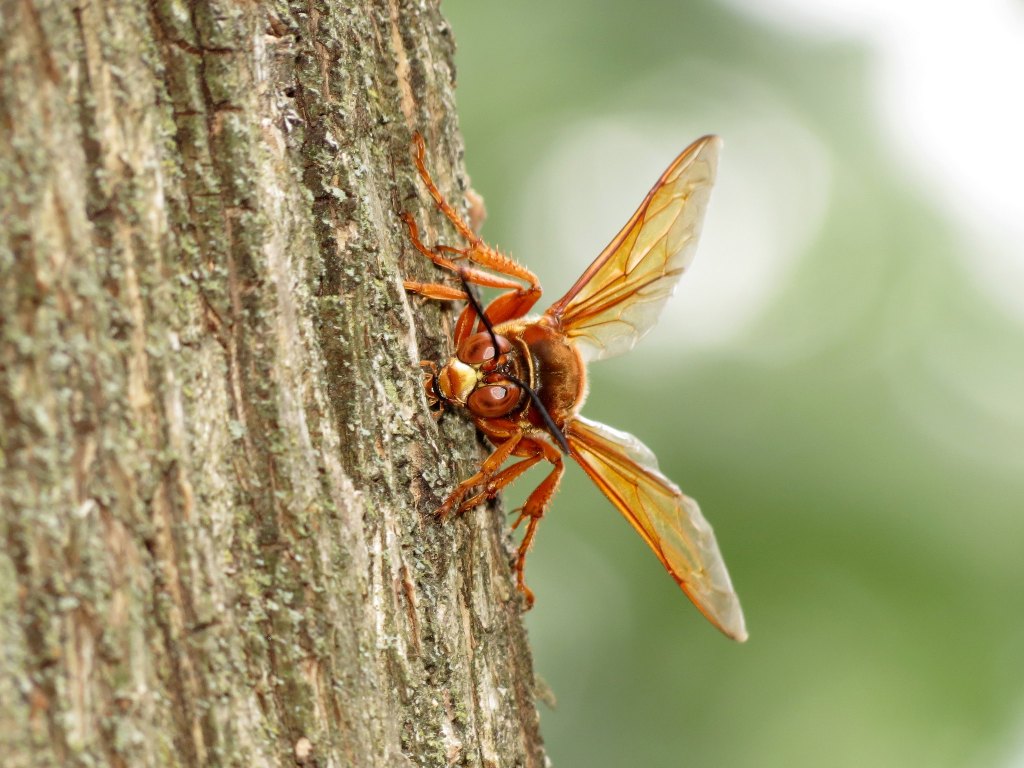



Claremore OK. This is the second summer these interesting creatures have taken up residence in our large, sandy garden bed in the front yard. Fascinating to watch. They will buzz me like little bullies while I weed and deadhead but I have never been stung. Morning walkers are alarmed until I explain they don’t sting. One neighbor suggested I post a sign “Cicada killers, won’t harm people”. Just might do that. There are 50 or so of these guys hovering and buzzing around. I have watched a female climb up a tree trunk, launch herself towards her burrow and land with extraordinary accuraciny. Ain’t nature wonderful!
Can you cover there hole ,not to kill the nestling? Also keep velvet ants out?
Great comment; as informative as article
Well written and educational. I find it fascinating how many kinds of wasp are prey specific for their eggs and larva. On the west coast I have observed “cricket” wasp and “banded wing grasshopper wasp” paralyze and fly off with victims almost twice their size. They appear almost to be hopping along the ground with the heavy burdened prey as they fly a few feet at a time.
Then we have the spider wasp like the mud daubers and the local “tarantula” hawks attempting to fly off with spiders their own size or much larger. Most of these wasp seem to have a following of parasitic or kleptoparasitic flies hanging out with them. It is very fascinating to find out bout the levels of parasite interaction through out the insect world, from galls parasites to larval and egg parasites, it surprising any of these species reach maturity.